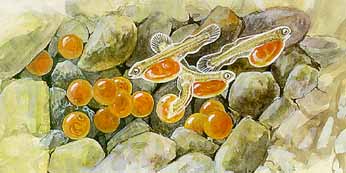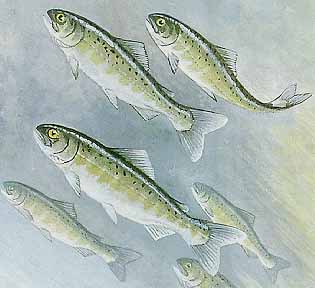 |
 |
Bibliography | Home |
Salmon Life Cycle: Early Stages
![]()
From the U.S. Fish and Wildlife Service brochure: Salmon of the
Pacific Coast
Illustrations © 1994 by Shari Erickson
| The eggs lie in the gravel through the winter, as the embryos within develop. In early spring, yolk-sac fry, or alevins, hatch. The tiny fish carry a food supply (a sac of egg yolk) attached to their bellies. They will not leave the protection of the gravel until the yolk is used up, 12 weeks or more. At that time, the young salmon, now called fry, swim up to the surface, gulp air to fill their swim bladders, and begin to feed. |  |
 |
Fry spend a year or more in their home stream in the case of some species, feeding on insects and other tiny animals. For these species, high quality stream habitat is particularly important. Streambed vegetation creates shade and supports many of the insects the young fish will eat. Snags, roots, and boulders provide hiding places and act as "breaks" that keep flood waters from sweeping the fry downstream. Chinook salmon head for the sea soon after they emerge from the gravel. |
| Environmental cues cause physical and behavioral changes called smolting: scales become larger, color turns silvery, tails lengthen and become more deeply forked. Smaller smolts let the current carry them downstream, tail first, while larger smolts swim actively. Much of their traveling is done at night to avoid predators. Human activity has created additional hazards, from dams to pollution, which reduce their chances of survival. |  |
Challenges:
Stream Life
|
![]()
| Salmon and Steelhead Life Cycle: | Early Stages | Adult | Spawning |
| Salmon and Steelhead Habitats: | Freshwater | Ocean |
![]()
| www.krisweb.com |